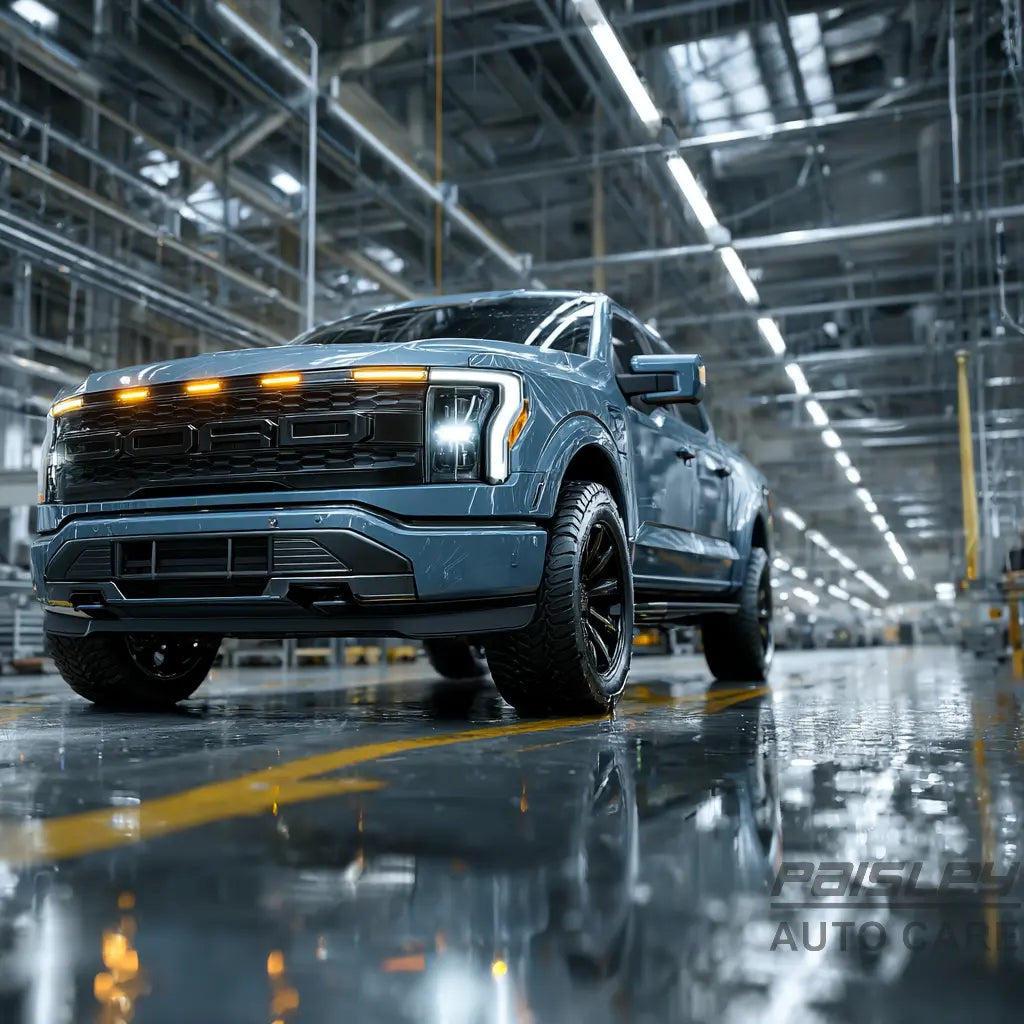Ford has officially hit the accelerator on its electric revolution, announcing a £1.6 billion Ford EV redesign that will completely transform its Louisville Assembly Plant in Kentucky, USA. The goal? To create a faster, more efficient manufacturing process for affordable electric vehicles, starting with a midsize electric pickup truck expected to be priced at around £23,500 when it launches in 2027.
For years, the biggest obstacle for many drivers considering the switch to electric has been price. Sure, EVs are clean, modern, and whisper-quiet — but they also often come with a price tag that could make you consider selling a kidney. The Ford EV redesign could change that, offering a practical, no-nonsense electric vehicle that doesn’t break the bank.
And here’s the twist: it’s not just about what Ford is building, but how it’s being built. This isn’t your grandad’s assembly line — this is the Universal EV Production System, a completely reimagined way of manufacturing cars.
What Is the Ford EV Redesign?
The Ford EV redesign refers to more than just a new model or facelift. It’s an overhaul of the entire production process, introducing what Ford calls the Universal EV Production System. In simple terms, it’s a shift away from the traditional conveyor belt style of building cars to a more modular, streamlined approach.
Here’s how it works: instead of slowly piecing together a car as it moves along a production line, Ford will assemble vehicles in three large modules:
-
Front Module – This is where the electric motors, suspension, and advanced electronics are fitted. Essentially, it’s the car’s “brain and brawn” all in one.
-
Middle Module – The passenger compartment, complete with all the comfort and convenience features we’ve come to expect, from heated seats to cupholders for that service station latte.
-
Rear Module – The suspension system, boot or load bed, and other rear-end essentials.
Once these modules are ready, they’re joined together like a high-tech Lego set. This clever approach means production can be up to 40% faster, vehicles can be lighter thanks to fewer unnecessary parts, and costs can be kept down — savings that could (in theory) be passed on to the buyer.
Why Ford Is Making the Change
The Ford EV redesign isn’t happening in a vacuum. Ford, like many other manufacturers, is facing growing pressure from three major directions:
-
Government Regulations – With the UK’s 2035 petrol and diesel ban on the horizon, and similar rules in the US and EU, automakers need to electrify their line-ups quickly.
-
Competition – Affordable Chinese EV brands such as BYD and MG are already making serious waves in the global market. Tesla, meanwhile, continues to dominate EV sales despite its prices creeping higher.
-
Consumer Demand – Surveys consistently show that drivers want EVs, but they want them at a price that makes financial sense. A £23,500 pickup is far more accessible than the £40k+ price tags we often see.
By rethinking how cars are built, Ford can compete not just on brand recognition, but on value.
The First Model: An Affordable Electric Pickup
The first product of the Ford EV redesign will be a midsize electric pickup truck, launching in 2027. While full details are still under wraps, we know it’s expected to:
-
Be priced from around £23,500
-
Use a 400-volt lithium iron phosphate (LFP) structural battery
-
Offer competitive range for both city and worksite use
-
Be built using the new modular production process
This is significant because affordable pickups are a rare sight in the EV world. Many existing electric trucks, such as the Ford F-150 Lightning or Rivian R1T, are impressive but carry hefty price tags north of £50,000. By undercutting the competition, Ford could open up a whole new segment of the market.
How the Modular Build Works
In traditional automotive manufacturing, cars move slowly down an assembly line, with dozens of workstations adding parts in a fixed order. It’s reliable, but it’s also time-consuming and space-hungry.
The Ford EV redesign ditches that approach entirely. Instead, cars are built as independent modules in separate work areas before being brought together for final assembly.
Think of it like this: instead of cooking a roast dinner by making the meat, veg, and potatoes all in the same oven, Ford is cooking them separately and then plating them up together. The result? A meal — or in this case, a car — that’s ready faster, with fewer bottlenecks in the process.
Benefits of the Ford EV Redesign
Ford claims this overhaul will bring several key benefits:
-
Speed – Up to 40% faster production times
-
Cost Savings – Reduced complexity and fewer parts mean lower manufacturing costs
-
Flexibility – Easier to build different models on the same production line
-
Weight Reduction – Fewer components mean lighter vehicles and better efficiency
-
Scalability – The same system can be rolled out to other plants worldwide
From an industry perspective, these are big claims. If Ford delivers, the Ford EV redesign could become a model that other manufacturers rush to copy.
Impact on the UK Market
While the Louisville plant is in the US, the Ford EV redesign could have a huge impact in the UK. Affordable EVs are in high demand here, especially as government incentives shrink and running costs become a bigger selling point.
If Ford decides to bring its affordable electric pickup — or future modular-built EVs — to the UK, they could become serious contenders in both personal and commercial markets. Builders, delivery drivers, and small business owners could finally have a reasonably priced, practical EV option.
Challenges Ahead
Of course, no major redesign comes without risks. The Ford EV redesign will need to overcome:
-
Consumer Skepticism – Buyers might worry that a cheaper EV means cheaper build quality.
-
Charging Infrastructure – Even the most affordable EV won’t win everyone over if public charging remains patchy in rural areas.
-
Market Competition – By 2027, other manufacturers will also have released their own affordable EVs, potentially crowding the space.
Why This Matters for the Future of EVs
The Ford EV redesign could be the push the industry needs to make EVs truly mainstream. By rethinking manufacturing, Ford is tackling two of the biggest barriers to adoption: cost and production speed.
If this works, it could trigger an “EV price war” — and for once, that’s a battle where the consumer wins. Lower prices, more choice, and faster delivery times could make switching to electric a no-brainer for millions of drivers.
Final Thoughts
The Ford EV redesign isn’t just about one car — it’s about changing the way cars are built entirely. The combination of modular production, a focus on affordability, and the promise of a practical £23,500 electric pickup is a bold move in an industry that often moves at a snail’s pace when it comes to change.
Of course, the proof will be in the driving. If the first model delivers on range, performance, and price, Ford could find itself leading the charge (pun fully intended) into a new era of electric mobility.
Until then, it’s a fascinating glimpse into how the next generation of EVs might be made — faster, cheaper, and maybe even with enough cupholders for all your overpriced motorway coffees.






